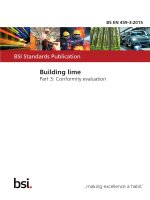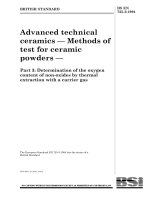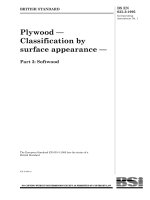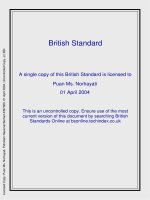Bsi bs en 61300 3 53 2015
Bạn đang xem bản rút gọn của tài liệu. Xem và tải ngay bản đầy đủ của tài liệu tại đây (1.51 MB, 24 trang )
BS EN 61300-3-53:2015
BSI Standards Publication
Fibre optic interconnecting
devices and passive
components — Basic test and
measurement procedures
Part 3-53: Examinations and Measurements
— Encircled angular flux (EAF) measurement method based on two-dimensional
far field data from step index multimode
waveguide (including fibre)
BRITISH STANDARD
BS EN 61300-3-53:2015
National foreword
This British Standard is the UK implementation of EN 61300-3-53:2015. It is
identical to IEC 61300-3-53:2015.
The UK participation in its preparation was entrusted by Technical
Committee GEL/86, Fibre optics, to Subcommittee GEL/86/2, Fibre optic
interconnecting devices and passive components.
A list of organizations represented on this committee can be obtained on
request to its secretary.
This publication does not purport to include all the necessary provisions of
a contract. Users are responsible for its correct application.
© The British Standards Institution 2015.
Published by BSI Standards Limited 2015
ISBN 978 0 580 82206 3
ICS 33.180.20
Compliance with a British Standard cannot confer immunity from
legal obligations.
This British Standard was published under the authority of the
Standards Policy and Strategy Committee on 31 March 2015.
Amendments/corrigenda issued since publication
Date
Text affected
BS EN 61300-3-53:2015
EUROPEAN STANDARD
EN 61300-3-53
NORME EUROPÉENNE
EUROPÄISCHE NORM
March 2015
ICS 33.180.20
English Version
Fibre optic interconnecting devices and passive components Basic test and measurement procedures - Part 3-53:
Examinations and measurements - Encircled angular flux (EAF)
measurement method based on two-dimensional far field data
from step index multimode waveguide (including fibre)
(IEC 61300-3-53:2015)
Dispositifs d'interconnexion et composants passifs à fibres
optiques - Procédures fondamentales d'essais et de
mesures - Partie 3-53 : Examens et mesures - Méthode de
mesure du flux angulaire inscrit (EAF) fondée sur les
données bidimensionnelles de champ lointain d'un guide
d'onde multimodal à saut d'indice (fibre incluse)
(IEC 61300-3-53:2015)
Lichtwellenleiter - Verbindungselemente und passive
Bauteile -Grundlegende Prüf- und Messverfahren - Teil 353: Untersuchungen und Messungen - Verfahren zur
Messung des winkelabhängigen begrenzten Lichtstroms
(EAF) basierend auf den zweidimensionalen Fernfelddaten
einer Mehrmodenfaser
(IEC 61300-3-53:2015)
This European Standard was approved by CENELEC on 2015-03-12. CENELEC members are bound to comply with the CEN/CENELEC
Internal Regulations which stipulate the conditions for giving this European Standard the status of a national standard without any alteration.
Up-to-date lists and bibliographical references concerning such national standards may be obtained on application to the CEN-CENELEC
Management Centre or to any CENELEC member.
This European Standard exists in three official versions (English, French, German). A version in any other language made by translation
under the responsibility of a CENELEC member into its own language and notified to the CEN-CENELEC Management Centre has the
same status as the official versions.
CENELEC members are the national electrotechnical committees of Austria, Belgium, Bulgaria, Croatia, Cyprus, the Czech Republic,
Denmark, Estonia, Finland, Former Yugoslav Republic of Macedonia, France, Germany, Greece, Hungary, Iceland, Ireland, Italy, Latvia,
Lithuania, Luxembourg, Malta, the Netherlands, Norway, Poland, Portugal, Romania, Slovakia, Slovenia, Spain, Sweden, Switzerland,
Turkey and the United Kingdom.
European Committee for Electrotechnical Standardization
Comité Européen de Normalisation Electrotechnique
Europäisches Komitee für Elektrotechnische Normung
CEN-CENELEC Management Centre: Avenue Marnix 17, B-1000 Brussels
© 2015 CENELEC All rights of exploitation in any form and by any means reserved worldwide for CENELEC Members.
Ref. No. EN 61300-3-53:2015 E
BS EN 61300-3-53:2015
EN 61300-3-53:2015
-2-
Foreword
The text of document 86B/3850/FDIS, future edition 1 of IEC 61300-3-53, prepared by SC 86B "Fibre
optic interconnecting devices and passive components" of IEC/TC 86 "Fibre optics" was submitted to
the IEC-CENELEC parallel vote and approved by CENELEC as EN 61300-3-53:2015.
The following dates are fixed:
–
latest date by which the document has to be implemented at
national level by publication of an identical national
standard or by endorsement
(dop)
2015-12-12
–
latest date by which the national standards conflicting with
the document have to be withdrawn
(dow)
2018-03-12
Attention is drawn to the possibility that some of the elements of this document may be the subject of
patent rights. CENELEC [and/or CEN] shall not be held responsible for identifying any or all such
patent rights.
Endorsement notice
The text of the International Standard IEC 61300-3-53:2015 was approved by CENELEC as a
European Standard without any modification.
In the official version, for Bibliography, the following notes have to be added for the standards
indicated:
IEC 60793-2-30
NOTE
Harmonized as EN 60793-2-30.
IEC 60793-2-40
NOTE
Harmonized as EN 60793-2-40.
IEC 60793-1-43
NOTE
Harmonized as EN 60793-1-43.
-3-
BS EN 61300-3-53:2015
EN 61300-3-53:2015
Annex ZA
(normative)
Normative references to international publications
with their corresponding European publications
The following documents, in whole or in part, are normatively referenced in this document and are
indispensable for its application. For dated references, only the edition cited applies. For undated
references, the latest edition of the referenced document (including any amendments) applies.
NOTE 1 When an International Publication has been modified by common modifications, indicated by (mod), the relevant
EN/HD applies.
NOTE 2 Up-to-date information on the latest versions of the European Standards listed in this annex is available here:
www.cenelec.eu.
Publication
IEC 60825-1
Year
-
IEC 61300-1
-
Title
EN/HD
Safety of laser products -- Part 1:EN 60825-1
Equipment classification and requirements
Fibre optic interconnecting devices andEN 61300-1
passive components - Basic test and
measurement procedures -- Part 1:
General and guidance
Year
-
–2–
BS EN 61300-3-53:2015
IEC 61300-3-53:2015 © IEC 2015
CONTENTS
1
Scope ............................................................................................................................ 6
2
Normative references..................................................................................................... 6
3
Terms and definitions .................................................................................................... 6
4
Standard atmospheric conditions ................................................................................... 7
5
Apparatus ...................................................................................................................... 7
5.1
General ................................................................................................................. 7
5.2
Measurement method 1: fθ lens imaging ................................................................ 8
5.2.1
General ......................................................................................................... 8
5.2.2
Micro-positioner ............................................................................................. 8
5.2.3
FFP optical system ........................................................................................ 8
5.2.4
Camera .......................................................................................................... 8
5.2.5
Computer (EAF analyser module) ................................................................... 9
5.2.6
Calibration light source .................................................................................. 9
5.3
Measurement method 2: direct imaging .................................................................. 9
5.3.1
General ......................................................................................................... 9
5.3.2
Micro-positioner ............................................................................................. 9
5.3.3
Optical power ................................................................................................. 9
5.3.4
Alignment ...................................................................................................... 9
5.3.5
Detector ......................................................................................................... 9
5.3.6
Single-mode fibre ......................................................................................... 10
5.3.7
Imaging device ............................................................................................. 10
6
Sampling and specimens ............................................................................................. 11
7
Geometric calibration ................................................................................................... 11
8
Measurement procedure .............................................................................................. 12
8.1
Safety ................................................................................................................. 12
8.2
Far field image acquisition ................................................................................... 12
8.2.1
General ....................................................................................................... 12
8.2.2
Waveguide end-face alignment ..................................................................... 12
8.2.3
Light source image acquisition ..................................................................... 12
8.3
Removal of background noise .............................................................................. 13
8.4
Centre determination ........................................................................................... 13
8.4.1
General ....................................................................................................... 13
8.4.2
Method A: Optical centre determination ........................................................ 13
8.4.3
Method B: Mechanical centre determination .................................................. 14
8.5
Computation of encircled angular flux .................................................................. 14
9
Results ........................................................................................................................ 16
9.1
Information available with each measurement ...................................................... 16
9.2
Information available upon request ...................................................................... 16
10 Details to be specified ................................................................................................. 16
Annex A (informative) System requirements: measurement method 1 – Field optical
system ........................................................................................................................ 18
A.1
General ............................................................................................................... 18
A.2
Requirements ...................................................................................................... 18
Annex B (informative) System requirements: measurement method 2 – Direct imaging ....... 19
B.1
General ............................................................................................................... 19
BS EN 61300-3-53:2015
IEC 61300-3-53:2015 © IEC 2015
–3–
B.2
Requirements ...................................................................................................... 19
Bibliography ....................................................................................................................... 20
Figure 1 – Apparatus configuration: Measurement method 1: fθ lens imaging ......................... 8
Figure 2 – Far field optical system diagram ........................................................................... 8
Figure 3 – Apparatus configuration: measurement method 2 – Direct imaging using an
integrating sphere ............................................................................................................... 10
Figure 4 – Apparatus configuration: measurement method 2 – Direct imaging using a
single-mode fibre ................................................................................................................ 10
Figure 5 – Apparatus configuration: measurement method 2 – Direct imaging using an
imaging device ................................................................................................................... 11
Figure 6 – Calibration apparatus example............................................................................ 12
Figure 7 – Acquired far field image ...................................................................................... 13
Figure 8 – Acquired far field image with false colour ............................................................ 13
Figure 9 – Optical centre determination ............................................................................... 14
Figure 10 – Coordinate conversion to polar coordinate on the image sensor plane ............... 15
Figure 11 – Standard encircled angular flux chart ................................................................ 16
Figure A.1 – An example of an optical system using an fθ lens ............................................. 18
–6–
BS EN 61300-3-53:2015
IEC 61300-3-53:2015 © IEC 2015
FIBRE OPTIC INTERCONNECTING DEVICES
AND PASSIVE COMPONENTS –
BASIC TEST AND MEASUREMENT PROCEDURES –
Part 3-53: Examinations and measurements –
Encircled angular flux (EAF) measurement method based
on two-dimensional far field data from step index multimode
waveguide (including fibre)
1
Scope
This part of IEC 61300 is intended to characterize the encircled angular flux of measurement
step index multimode waveguide light sources, in which most of the transverse modes are
excited. The term waveguide is understood to include both channel waveguides and optical
fibres but not slab waveguides in this standard.
Encircled angular flux (EAF) is the fraction of the total optical power radiating from a step
index multimode waveguide’s core within a certain solid angle. The EAF is measured as a
function of the numerical aperture full angle. The basic approach is to collect, for every
measurement, two dimensional far field data using a calibrated camera and to convert them
mathematically into encircled angular flux.
2
Normative references
The following documents, in whole or in part, are normatively referenced in this document and
are indispensable for its application. For dated references, only the edition cited applies. For
undated references, the latest edition of the referenced document (including any
amendments) applies.
IEC 60825-1, Safety of laser products – Part 1: Equipment classification and requirements
IEC 61300-1, Fibre optic interconnecting devices and passive components − Basic test and
measurement procedures − Part 1: General and guidance
3
Terms and definitions
For the purposes of this document, the following terms and definitions apply.
3.1
encircled angular flux
EAF
fraction of the total optical power radiating from a step index multimode waveguide’s core
within a certain solid angle
3.2
f θ lens
lens converting the angle of incidence of the input beam, θ, into the output beam height, h
Note 1 to entry:
The relationship between them is h = fθ, where f is the focal length of the lens.
BS EN 61300-3-53:2015
IEC 61300-3-53:2015 © IEC 2015
–7–
3.3
numerical aperture
NA
sine of the vertex half-angle of the largest cone of meridional rays that can enter or leave the
core of an optical waveguide, multiplied by the refractive index of the medium in which the
cone is located.
3.4
far field pattern
FFP
angular distribution of light radiating from a waveguide’s core, which corresponds to the
optical power distribution on a plane normal to the waveguide axis some distance from its end
facet.
Note 1 to entry: The distance depends on the largest waveguide cross section, a, the wavelength, lambda and the
angle, ϕ , to the optical axis. It is abbreviated to FFP. In the far field region the shape of the distribution does not
change as the distance from the waveguide end facet increases; the distribution only scales in size with distance, L.
L >>
2a 2 (cos ϕ )
2
λ
3.5
far field image
far field pattern formed on an imaging device
3.6
centroid
optical centre of the far field image
3.7
neutral density filter
ND
filter that attenuates light of all colours equally
4
Standard atmospheric conditions
The standard atmospheric conditions are specified in IEC 61300-1.
5
5.1
Apparatus
General
The optical source multimode waveguide shall be long enough to ensure that all cladding
modes are stripped by passage through the waveguide. Often the fibre coating or tight buffer
is sufficient to perform this function. Alternatively a cladding mode stripper shall be used in
the source launch optical multimode fibre. An example of a typical cladding mode stripper
which would be suitable for optical fibre is sufficient windings of the fibre around a mandrel of
an appropriate diameter. The windings also have a more important essential effect to fully fill
the transverse modes across the maximum mode field diameter. It should be checked that all
of the transverse modes of the fibre are sufficiently well excited. This can be done by
comparing the FFPs for different lengths of the launch fibre or different light sources. Once
the FFP no longer changes in form as the launch fibre length is increased there is no need to
increase the length further.
–8–
5.2
5.2.1
BS EN 61300-3-53:2015
IEC 61300-3-53:2015 © IEC 2015
Measurement method 1: f θ lens imaging
General
In theory, this measurement method, which is effectively a coherent optical method to Fourier
Transform the near field to the far field using a lens, does not operate well using very
wideband optical sources. Experimentally it has been shown to operate sufficiently well for
sources up to 30 nm bandwidth which are most commonly used.
Figure 1 below shows the apparatus configuration. The measurement system consists of a
micro-positioner, a far field broadband optical system, a camera and computer (beam analysis
module). An appropriate type of camera (detector) should be chosen to suit the wavelength.
FFP optical system
Camera
(image sensor)
Optical fibre
Micro-positioner
Computer
(EAF analyser module)
IEC
Figure 1 – Apparatus configuration: Measurement method 1: f θ lens imaging
5.2.2
Micro-positioner
The micro-positioner shall have a function of fixing an optical waveguide and moving in three
directions (X, Y, Z). In addition yaw and pitch controls are recommended.
5.2.3
FFP optical system
As shown in Figure 2, basically, an f θ lens can directly convert input the light from the
multimode waveguide to a far field image, however, scaling the far field image in order to fit
the image sensor in the camera and adjustment of the light intensity in order to prevent
saturation may be required. The FFP optical system shall be chosen to operate at the
measurement wavelength across the required measurement bandwidth to match that of the
detection system. See Annex A for more information.
f θ objective lens
Field lens
Imaging relay lens
IEC
Figure 2 – Far field optical system diagram
5.2.4
Camera
Although, the detector is typically a charge-coupled device (CCD) or a complementary metal
oxide semiconductor (CMOS) camera, other types of array cameras may be considered. The
type of image sensor shall be chosen by the measurement wavelength. Absolute radiometric
measurement of flux (optical power flow) is not required.
BS EN 61300-3-53:2015
IEC 61300-3-53:2015 © IEC 2015
5.2.5
–9–
Computer (EAF analyser module)
Since the acquired image contains many thousands of pixels, and the image conversion into
encircled angular flux requires substantial computation, a computer is required. The computer
will usually be connected to the image sensor through an image acquisition board (or with an
embedded image acquisition circuit) and installed beam analysis software.
5.2.6
Calibration light source
Calibration light source is used when calibrating the apparatus in Clause 7. The calibration
source is assumed to be broadband and incoherent so that speckle is not a problem, and to
have a sufficiently symmetrical far field distribution so that the calculated centroid of the far
field indicates the location of the optical centre axis of the waveguide with sufficient accuracy
for the purposes of this standard.
5.3
5.3.1
Measurement method 2: direct imaging
General
There are three alternative methods to detect the far field. One uses a detector, one uses a
single-mode fibre and the other uses a camera.
5.3.2
Micro-positioner
Both the input step index multimode waveguide source and the photo detector (PD) shall be
mounted on high precision motorized translation stages for accurate alignment with submicron step adjustment to maximize the light through the waveguide.
5.3.3
Optical power
The output from the multimode waveguide shall be set to a power level of 0 dBm.
5.3.4
Alignment
Firstly, the input waveguide and detector shall be properly aligned to obtain the maximum
output power.
5.3.5
Detector
An integrating sphere PD preceded by a pinhole shall be placed sufficiently far from the
optical source launch multimode waveguide facet so as to be in the Fraunhofer or far field.
The Fraunhofer far field occurs when L >> D 2 / λ where L is the distance of the detection plane
from the waveguide end facet, D is the diameter of the multimode waveguide core or strictly
mode field diameter and λ is the wavelength. For example, a large area integrating sphere PD
preceded by a pinhole, shown in Figure 3, shall be used to measure the integrated output
optical power so avoiding inconsistencies due to laser speckle and spatial variation of
efficiency across the photodiode detector. In this method the integrating sphere and its
pinhole are moved in X and Y to sample the far field. This has the advantage that a very large
area can be sampled. Moreover, it can also be moved in an arc on a goniometer so that its
input facet always faces the centre of the core of the multimode waveguide output. This
goniometric method can also be used to calibrate the far field in the f θ imaging method as the
far field is measured directly as a function of angle. If the detector aperture is instead moved
across an XY plane then the lateral position from the optical axis shall be converted to an
angle of divergence from the optical axis. The angle is the arctangent of the ratio of the lateral
X or Y position to the distance L. Therefore, considerable care needs to be taken to
accurately measure L.
– 10 –
Waveguide
(optical fibre)
Pin hole
L
Integrating
sphere PD
Controller
Micropositioner
BS EN 61300-3-53:2015
IEC 61300-3-53:2015 © IEC 2015
Motorized micropositioner
Computer
(EAF analyser module)
IEC
Figure 3 – Apparatus configuration: measurement method 2 –
Direct imaging using an integrating sphere
5.3.6
Single-mode fibre
The single-mode optical fibre shall be placed sufficiently far from the optical source launch
multimode waveguide facet so as to be in the Fraunhofer or far field. The Fraunhofer far field
occurs when L >> D 2 / λ where L is the distance of the detection plane from the waveguide end
facet, D is the diameter of the multimode waveguide core or strictly mode field diameter and λ
is the wavelength. For example, a single-mode fibre attached to a detector, shown in Figure 4,
shall be placed in the far field and moved in X and Y to sample the far field. This has the
advantage that a very large area can be sampled. Moreover, it can also be moved in an arc
on a goniometer so that its input facet always faces the centre of the core of the multimode
waveguide output. This goniometric method can also be used to calibrate the far field in the fθ
imaging method as the far field is measured directly as a function of angle. If the single-mode
fibre core is instead moved across an XY plane then the lateral position from the optical axis
shall be converted to an angle of divergence from the optical axis. The angle is the arctangent
of the ratio of the lateral X or Y position to the distance L. Therefore, considerable care needs
to be taken to accurately measure L.
Waveguide
(optical fibre)
L
Single-mode optical fibre
PD
Controller
Micropositioner
Motorized micropositioner
Computer
(EAF analyser module)
IEC
Figure 4 – Apparatus configuration: measurement method 2 –
Direct imaging using a single-mode fibre
5.3.7
Imaging device
An imaging device plane without any lens system shall be placed sufficiently far from the
optical source launch multimode waveguide facet so as to be in the Fraunhofer or far field.
The Fraunhofer far field occurs when L >> D 2 / λ where L is the distance of the detection plane
from the waveguide end facet, D is the diameter of the multimode waveguide core or strictly
mode field diameter and λ is the wavelength. For example, an imaging device, shown in
Figure 5, shall be placed L away from the exit facet of the multimode waveguide. The distance
L between the imaging device and the waveguide end facet is much larger than the core size
of the waveguide, so the field captured is the far field distribution. The imaging device may for
example, be a CCD camera with its lens removed so that the light distribution falls directly on
the CCD chip. The lateral position from the optical axis in the far field shall be converted to an
angle of divergence from the optical axis. The angle is the arctangent of the ratio of the lateral
BS EN 61300-3-53:2015
IEC 61300-3-53:2015 © IEC 2015
– 11 –
X or Y position to the distance L. Therefore, considerable care needs to be taken to
accurately measure L.
Waveguide
(optical fibre)
L
Camera
Controller
Micropositioner
Motorized micropositioner
Computer
(EAF analyser module)
IEC
Figure 5 – Apparatus configuration: measurement method 2 –
Direct imaging using an imaging device
6
Sampling and specimens
Light sources to be tested shall be chosen and prepared by the user of this standard, who
shall document the sampling and preparation procedures used. The only requirements on the
light sources under test are that they have an operating wavelength compatible with the
detector and fθ lens, and have optical connectors or splices compatible with the input port of
the apparatus. The construction details of the light sources are otherwise unspecified.
7
Geometric calibration
Calibration of the apparatus is critical to the accuracy of this measurement procedure.
Calibration shall be performed periodically. If the calibration is known to drift significantly
during a measurement interval, the drift of the source(s) shall be identified and eliminated. If
the apparatus is disassembled or its components in or affecting the optical path are otherwise
manipulated, calibration shall be performed before measurements are made.
The purpose of geometric calibration is to obtain the measurement data needed to compute
the conversion factor. The factor will be used to convert camera coordinates to light launching
angle relative to the optical axis of optical waveguide.
Calibration is performed to measure the conversion factor that relates the light launching
angle to the pixel of the detector corresponding to this angle. The factor has a unit of degree
per pixel, and will be used to convert camera coordinates to far field angle coordinates. The
collimated light source for geometric calibration, shown in Figure 6, shall have a spectral
power distribution similar to that of the measurement light source and the central wavelength
within 30 nm around the nominal wavelength of the measurement light source.
An example of the calibration procedure is stated below:
Step 1 Set a collimated light source whose incident angle relative to the optic axis of the far
field optical system can be precisely controlled. An example of the calibration apparatus is
shown in Figure 6.
Step 2 Measure the conversion factors from the whole range of angles to be measured with
an interval small enough (e.g. 1°) to enable accurate interpolation.
– 12 –
BS EN 61300-3-53:2015
IEC 61300-3-53:2015 © IEC 2015
Collimated light
Mirror
Precise goniometer
Far field
optical system
IEC
Figure 6 – Calibration apparatus example
Alternatively the direct imaging methods described in Clause 5 may be used for calibration.
8
Measurement procedure
8.1
Safety
All procedures in which an LED or a laser source is used as the optical source shall be
carried out using safety precautions in accordance with IEC 60825-1.
8.2
8.2.1
Far field image acquisition
General
Acquiring an image is central to the measurement of encircled angular flux. The approach to
image acquisition depends on the general characteristics of the light source being measured.
8.2.2
Waveguide end-face alignment
A waveguide end-face is placed at the front focal point of the FFP optical system. The live far
field image acquired on the computer display is adjusted to be in the centre of the display
using the X and Y axes of the micro-positioner, and to a minimum diameter and in focus using
the Z axis of the micro-positioner in 5.2.2.
8.2.3
Light source image acquisition
Measurement light sources are sufficiently incoherent and are sufficiently intense to easily get
good dynamic range, although attenuation may be required using ND filter. The acquired
image should be shown in the PC display as in Figure 7. The picture may be displayed with
false colour in Figure 8.
BS EN 61300-3-53:2015
IEC 61300-3-53:2015 © IEC 2015
– 13 –
IEC
Figure 7 – Acquired far field image
IEC
Figure 8 – Acquired far field image with false colour
8.3
Removal of background noise
The dark current of the camera which is acquired by obscuring the input light beforehand shall
be removed from the acquired image, or 0,5 % intensity of the peak power in the acquired
image shall be set as a threshold level to keep the parts of the image above this threshold.
8.4
8.4.1
Centre determination
General
One of the two methods needs to be used.
8.4.2
Method A: Optical centre determination
The encircled angular flux is computed with respect to the optical centroid of the FFP
distribution. As shown in Figure 9, the centroid of the acquired image shall be determined with
the use of Equation (1).
BS EN 61300-3-53:2015
IEC 61300-3-53:2015 © IEC 2015
– 14 –
y’
y
x
O
O’
x’
IEC
Figure 9 – Optical centre determination
∑ x ′∑ I (x ′, y ′)
x′
y′
O ( x = 0, y = 0 ) = O ′( x ′ = 0, y ′ = 0 ) −
,
∑∑ I ( x ′, y ′)
x′ y ′
where
∑ y ′∑ I (x ′, y ′)
x′
I ( x ′, y ′)
∑∑
x′ y ′
O’
is the origin of FFP optical system;
O
is the calculated centroid of the acquired image;
(x’, y’)
are the x-y coordinates based on the FFP optical system origin;
I(x’, y’)
is the light intensity at coordinate (x’, y’).
8.4.3
(1)
y′
Method B: Mechanical centre determination
The encircled angular flux is computed with respect to the optical central axis of the
measurement optics. The optical central axis of the measurement optics, O m , shall be
determined by measuring the far field pattern of a reference waveguide. The reference
waveguide shall be a single-mode fibre and the end-face of the fibre should be perpendicular
to the optical axis.
∑ x m′ ∑ I ( x m′ , y m′ )
x′
y′
Om ( x m = 0, y m = 0 ) = Om′ ( x m′ = 0, y m′ = 0 ) −
,
∑∑ I ( x m′ , y m′ )
x′ y ′
∑ y ′ ∑ I (x ′ , y ′ )
m
x′
m
y′
m
∑∑ I (x ′ , y ′ )
x′
y′
m
m
(2)
For method B, O’ m shall be fixed during a series of measurements.
8.5
Computation of encircled angular flux
Before computation of encircled angular flux, the x-y coordinates are converted to polar
coordinates using r and ϕ as shown in Figure 10(b). Applying r and ϕ to the encircled flux
equation, light intensity distribution on an FFP screen is described in Equation (3).
BS EN 61300-3-53:2015
IEC 61300-3-53:2015 © IEC 2015
– 15 –
y
r max
r
SI-MMF
θ
r max
r'
0
r
0
φ
x
FFP screen
2θ max
I(r,φ)
df
a)
b)
IEC
Figure 10 – Coordinate conversion to polar coordinate on the image sensor plane
𝐸𝐸(𝑟 ′ ) =
2𝜋 𝑟′
∫0 ∫0 𝐼(𝑟,𝜑)∙𝑟∙𝑑𝑑∙𝑑𝑑
2𝜋 𝑟𝑚𝑚𝑚
𝐼(𝑟,𝜑)∙𝑟∙𝑑𝑑∙𝑑𝑑
∫0 ∫0
(3)
Equation (4) is a simple equation that shows the relationship between r, θ and d f , and its
differential form (5):
𝑟 = 𝑑𝑓 · 𝑡𝑡𝑡(𝜃)
𝑟 · d𝑟 = 𝑑 2 · 𝑠𝑠𝑠(𝜃) · 𝑐𝑐𝑐 −3 (𝜃) · 𝑑𝑑
(4)
(5)
Replacing r with θ using Equation (4) and (5), Equation (6) is obtained. This shows encircled
angular flux EAF( θ′ ).
where
𝐸𝐴𝐹(𝜃
′)
=
2𝜋 𝜃′
𝑠𝑠𝑠(𝜃)
∙𝑑𝑑𝑑𝑑
𝑐𝑐𝑐3 (𝜃)
2𝜋 𝜃𝑚𝑚𝑚
𝑠𝑠𝑠(𝜃)
𝐼(𝑟,𝜑)∙ 3 ∙𝑑𝑑𝑑𝑑
∫0 ∫0
𝑐𝑐𝑐 (𝜃)
∫0 ∫0 𝐼(𝑟,𝜑)∙
(6)
r
is the radial distance from the origin corresponding to an angle between one ray
emitted from the multimode waveguide and the optical axis of the multimode
waveguide;
r max
is the radial distance from the origin corresponding to the maximum ray angle
which is approximately 30° for category A3 multimode fibre for example;
ϕ
is a circular angle in polar coordinates;
θ
is an angle between one ray emitted from the multimode waveguide and the
optical axis;
θ max
is the maximum ray angle which is approximately 30° for category A3 multimode
fibre for example;
df
is the distance between the end of multimode optical wave guide and FFP screen.
O and O m
are the calculated centroids discussed in 8.4.
An example of EAF is shown in Figure 11.
BS EN 61300-3-53:2015
IEC 61300-3-53:2015 © IEC 2015
– 16 –
1,0
0,8
EAF
0,6
0,4
0,2
0,0
0
10
Angle θ °
20
(deg)
30
IEC
Figure 11 – Standard encircled angular flux chart
9
9.1
Results
Information available with each measurement
Report the following with each measurement:
•
date and time of measurement;
•
identification of source;
•
nominal wavelength of source;
•
method of centre determination;
•
the encircled angular flux at each angle shall be reported after a series of measurements
is completed;
•
EAF as a graph as a function of angle θ (Figure 11), including any specified template
limits.
For method B specify the single-mode fibre and multimode fibre connectors and their lateral
and angular tolerances, if the measurements are referenced to the connector
9.2
Information available upon request
The following information shall be available upon request:
•
date of most recent calibration of equipment;
•
method of calibration of equipment;
•
the integration limit parameters(larger than the angle corresponding to the NA of DUT and
less than the field of view);
•
the original images used in the computations;
•
the derived centre, and if different, the centroid image;
•
the angular data functions computed in 8.5.
10 Details to be specified
The following details, as applicable, shall be stated in the relevant specification:
BS EN 61300-3-53:2015
IEC 61300-3-53:2015 â IEC 2015
17
ã
type of source to be measured;
•
sampling requirements, if any;
•
criteria to be met by sources;
•
any deviations to the procedure that may apply;
•
angle θ at which the EAF is to be reported;
•
the EAF template used to report results;
•
measurement uncertainty.
BS EN 61300-3-53:2015
IEC 61300-3-53:2015 © IEC 2015
– 18 –
Annex A
(informative)
System requirements: measurement method 1 –
Field optical system
A.1
General
An f θ lens can directly convert the distribution of intensity as a function of input light angle to
the distribution of intensity as a function of radius in the far field. However, scaling the far
field image in order to fit the image sensor in the camera may be required. In addition,
adjustment of the input light intensity in order to prevent the saturation of the image sensor
may also be required using an ND filter. Accordingly the far field optical system consists of an
fθ (telecentric) optical system and imaging optical system (relay lens). An ND filter may be
placed at the filter port.
Imaging relay lens
f θ objective lens
Field lens
CCD
Filter port
IEC
Figure A.1 – An example of an optical system using an f θ lens
A.2
Requirements
Requirements of the far field optical system are as follows:
Main lens system:
fθ objective lens;
Range of measurement angle to the optical axe: ±40° (NA = 0,64);
Resolution of measurement angle:
0,1° or less.
BS EN 61300-3-53:2015
IEC 61300-3-53:2015 © IEC 2015
– 19 –
Annex B
(informative)
System requirements: measurement method 2 –
Direct imaging
B.1
General
The principle of this measurement method is that light diverges from the step index multimode
waveguide connected to the light source and this light is allowed to diverge in free space
without passing through any lenses, prisms, apertures or other optical elements before it
impinges on the photodiode or CCD or CMOS detector apart from the case of the integrating
sphere where multiple internal reflections are permitted.
B.2
Requirements
An imaging device plane without any lens system shall be placed sufficiently far from the
optical source launch multimode waveguide facet so as to be in the Fraunhofer or far field.
The Fraunhofer far field occurs when L >> D 2 / λ where L is the distance of the detection plane
from the waveguide end facet, D is the diameter of the multimode waveguide core (or strictly
mode field diameter) and λ is the wavelength. The distance L between the imaging device and
the waveguide end facet is much larger than the core size of the waveguide, so the field
captured is the far field distribution. It shall be confirmed that all of the light distribution is
detected by the CCD camera, which may require the camera to be moved closer to the light
source or alternatively multiple images may be stitched together.
Distance of detection surface from waveguide end facet: L >> D 2 / λ
Range of measurement angle to the optical axes:
±40° (NA = 0,64)
Resolution of measurement angle:
0,1° or less
– 20 –
BS EN 61300-3-53:2015
IEC 61300-3-53:2015 © IEC 2015
Bibliography
[1]
MOST Specification of Physical Layer Rev. 1.1, 09/2003
[2]
IEC 60793-2-30, Optical fibres – Part 2-30: Product specifications – Sectional
specification for category A3 multimode fibres
[3]
IEC 60793-2-40, Optical fibres – Part 2-40: Product specifications – Sectional
specification for category A4 multimode fibres
[4]
IEC 60793-1-43, Optical fibres − Part 1-43: measurement methods and test procedures
– Numerical aperture
[5]
IEC 61745, End-face image analysis procedure for the calibration of optical fibre
geometry test sets
_____________
This page deliberately left blank
NO COPYING WITHOUT BSI PERMISSION EXCEPT AS PERMITTED BY COPYRIGHT LAW
British Standards Institution (BSI)
BSI is the national body responsible for preparing British Standards and other
standards-related publications, information and services.
BSI is incorporated by Royal Charter. British Standards and other standardization
products are published by BSI Standards Limited.
About us
Revisions
We bring together business, industry, government, consumers, innovators
and others to shape their combined experience and expertise into standards
-based solutions.
Our British Standards and other publications are updated by amendment or revision.
The knowledge embodied in our standards has been carefully assembled in
a dependable format and refined through our open consultation process.
Organizations of all sizes and across all sectors choose standards to help
them achieve their goals.
Information on standards
We can provide you with the knowledge that your organization needs
to succeed. Find out more about British Standards by visiting our website at
bsigroup.com/standards or contacting our Customer Services team or
Knowledge Centre.
Buying standards
You can buy and download PDF versions of BSI publications, including British
and adopted European and international standards, through our website at
bsigroup.com/shop, where hard copies can also be purchased.
If you need international and foreign standards from other Standards Development
Organizations, hard copies can be ordered from our Customer Services team.
Subscriptions
Our range of subscription services are designed to make using standards
easier for you. For further information on our subscription products go to
bsigroup.com/subscriptions.
With British Standards Online (BSOL) you’ll have instant access to over 55,000
British and adopted European and international standards from your desktop.
It’s available 24/7 and is refreshed daily so you’ll always be up to date.
You can keep in touch with standards developments and receive substantial
discounts on the purchase price of standards, both in single copy and subscription
format, by becoming a BSI Subscribing Member.
PLUS is an updating service exclusive to BSI Subscribing Members. You will
automatically receive the latest hard copy of your standards when they’re
revised or replaced.
To find out more about becoming a BSI Subscribing Member and the benefits
of membership, please visit bsigroup.com/shop.
With a Multi-User Network Licence (MUNL) you are able to host standards
publications on your intranet. Licences can cover as few or as many users as you
wish. With updates supplied as soon as they’re available, you can be sure your
documentation is current. For further information, email
BSI Group Headquarters
389 Chiswick High Road London W4 4AL UK
We continually improve the quality of our products and services to benefit your
business. If you find an inaccuracy or ambiguity within a British Standard or other
BSI publication please inform the Knowledge Centre.
Copyright
All the data, software and documentation set out in all British Standards and
other BSI publications are the property of and copyrighted by BSI, or some person
or entity that owns copyright in the information used (such as the international
standardization bodies) and has formally licensed such information to BSI for
commercial publication and use. Except as permitted under the Copyright, Designs
and Patents Act 1988 no extract may be reproduced, stored in a retrieval system
or transmitted in any form or by any means – electronic, photocopying, recording
or otherwise – without prior written permission from BSI. Details and advice can
be obtained from the Copyright & Licensing Department.
Useful Contacts:
Customer Services
Tel: +44 845 086 9001
Email (orders):
Email (enquiries):
Subscriptions
Tel: +44 845 086 9001
Email:
Knowledge Centre
Tel: +44 20 8996 7004
Email:
Copyright & Licensing
Tel: +44 20 8996 7070
Email:









